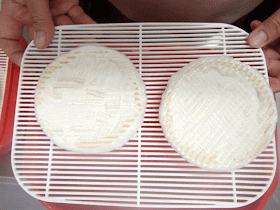
Most people do not know the difference between Camembert and Brie, and this is understandable as the recipes are much the same. Both cheeses are French in origin and are named for the region that they come from. Camembert comes from Camembert, in the Normandy region of France. Camembert was made from whole, raw milk from Norman cows. Camembert is customarily shaped in disks of 11 cm in diameter, 4 cm thick, weighing about 250 grams. Brie comes from two areas to the south and east of Paris. The process used to make Brie is very similar to that used for Camembert, but Brie is made in larger wheels, ranging from about 500 grams to 3 kilos in weight, 20 to 40cm in diameter and 2.5 to 4cm thick. Camembert’s smaller size affects its final taste and texture. It tends to age slightly more quickly, and the flavor of Camembert will therefore be somewhat stronger than Brie. This is because the smaller size causes the Camembert to lose moisture more quickly, which concentrates its flavour within the cheese.
The Camembert below is made specifically for the home cheese maker in smaller sizes to allow for quicker ripening and ease of storage and consumption in the home. This recipe will make four cheeses with a 10 cm diameter and 4-5 cm height.
Ingredients:
- 4 litres full cream milk 1/8 tsp Calcium Chloride diluted in 1/4 cup of non chlorinated water
- I dose of Mesophilic starter culture. See packet directions.
- 1 dose White Mould (Penicillium Candidum) See packet directions
- 1/4 tsp Liquid Rennet or 1/4 of a Rennet tablet diluted in 1/4 cup of non chlorinated water
- Cheese Salt to sprinkle on surface of cheese
- Medium stainless steel pot
- A second larger pot to put the first pot into to act as a water jackets Cheese thermometer Stainless steel curd knife
- Stainless Steal perforated spoon
- Stainless steel ladle
- Cheese moulds (The size you select will determine whether you are making Brie or camembert) Cheese boards & Cheese draining mats
- Aging or ripening box (with rack in the bottom)
- Place your milk into the first stainless steel pot and then place this pot into a second, larger pot with water in it to act as a water jacket.
- If sing pasteurised and homogenised milk, add ¼ tsp of calcium chloride, diluted in ¼ cut of non chlorinated water and mix well.
- Using indirect heat, heat your milk to 32 decrees C. Add the starter culture and the white mould, mixing in well and allow to ripen for 45 minutes, maintaining the temperature at 32 degrees C.
- Add the diluted rennet and mix well using a gentle up and down motion for one minute. Allow to set at 32 degrees C for 45 minutes.

- Test for a clean brake. Once a clean brake has been achieved, it is time to cut the curd.
- Cut the curd into 1.5cm cubes and then allow it to rest for 15 minutes.

- Gently stir the curds for 15 minute, while at the same time maintaining the temperature at 32 degrees C.
- Allow to rest for 15 minutes

- Using sterile cheese boards, cheese mats and hoops, sent your cheese board on a draining tray, place a cheese mat on the cheese board and then set your hoop on the cheesed mat.
- Drain off they whey down to the level of the curds and then gently ladle the curds into your hoop(s). The whey will drain away through the bottom of the hoop(s). Once the curds are all in the hoop(s), place a second sterile cheese mat on top, followed by a second sterile cheese board, making a cheese board ‘sandwich’.


- Allow to rest for one hour. The weight of the curds will press the excess whey out and the cheese with sink as this occurs.
- After one hour carefully flip the cheese over by picking up the cheese board ‘sandwich’. Use one careful but swift action so that the cheese does not break as you do this. It is important that the surface of the cheese does not tear.
- Rest the cheese a further hour and then using the same technique as before, flip the cheese again.
- Turn the cheeses again, at hourly intervals for a further four times.
- Remove the cheese from the mould and sprinkle the entire surface of the cheese with cheese salt, rubbing it in gently.
- Place the cheese in a humid environment at 10 to 13 degrees C and let rest for 10 days, turning you cheese over every three days. You can use a temperature and humidity controlled ‘cheese cave’, or if you do not have a ‘cheese cave’, use a converted fridge or an esky. To keep the humidity up if using a fridge it is best to use a ripening box, which is a plastic box with a removable mat in the bottom to keep the cheese off the bottom of the box. This allows any further excess whey to drain away form your cheese. If moisture collects on the lid of your ripening box, just wipe it off to stop to dripping on your cheese.
- After the 10 days your cheese should be covered with a coating of white mound. Remove your cheese form the ‘cheese cave’ and/or ripening box and wrap it in cheese wrap. Replace the cheese in the ‘cheese cave’ or ripening box and allow it to age for a further 2 to 4 weeks. The longer you leave this cheese the softer and runnier the cheese will become and the stronger the flavour. The length of time you allow this cheese to age will be determined by your personal taste.


No comments:
Post a Comment